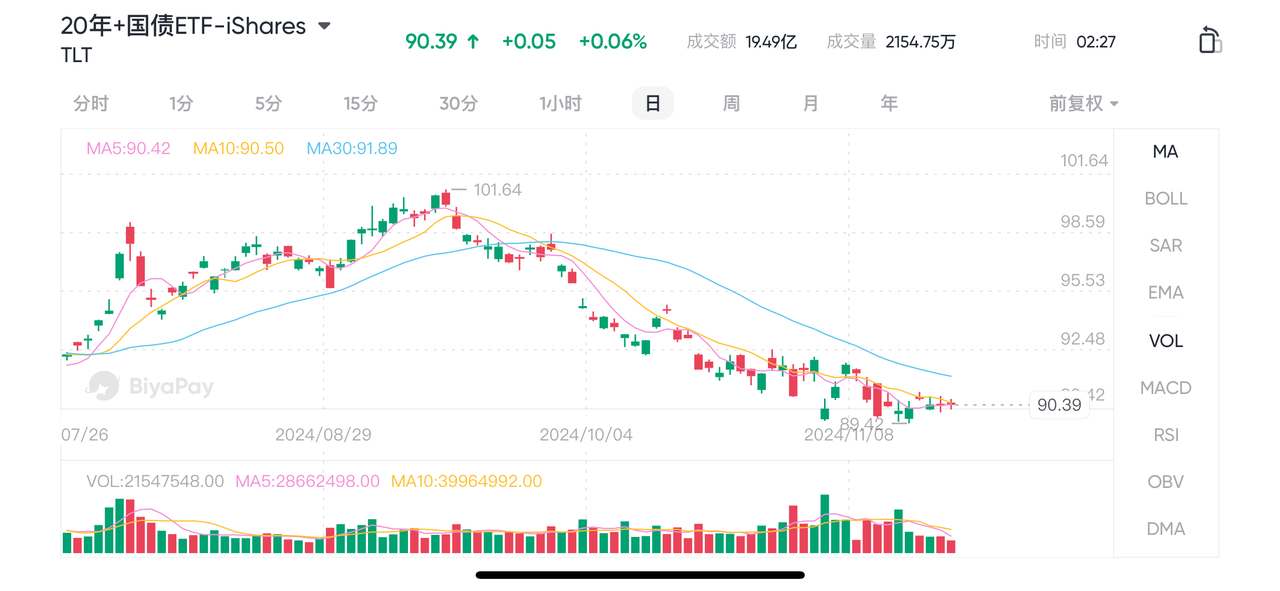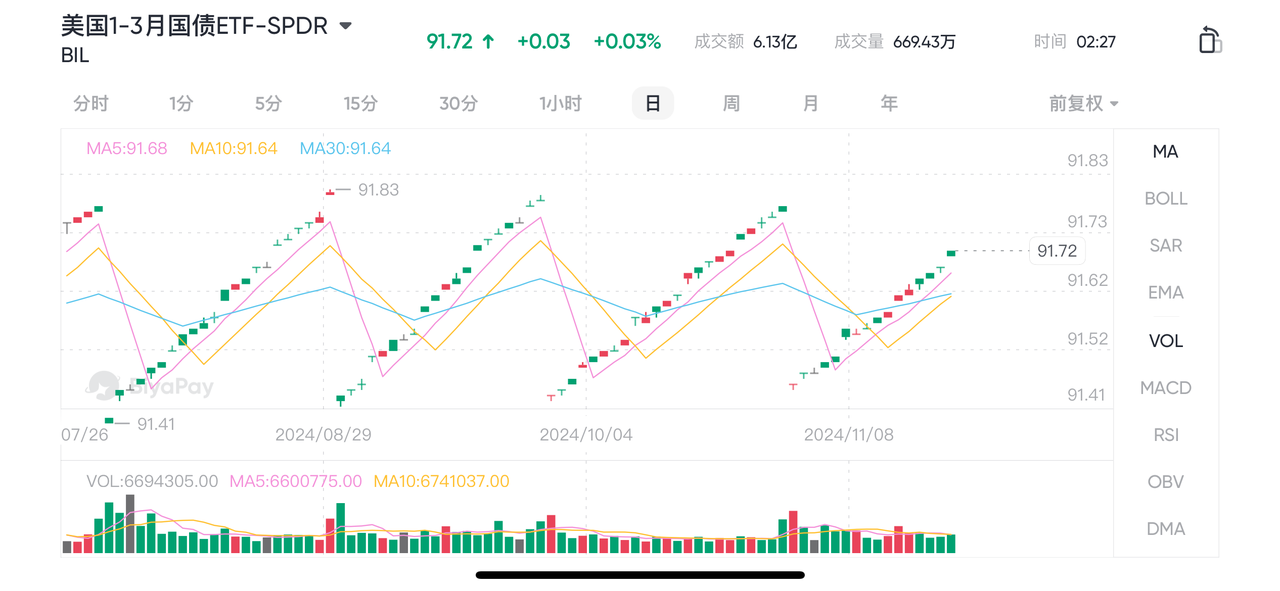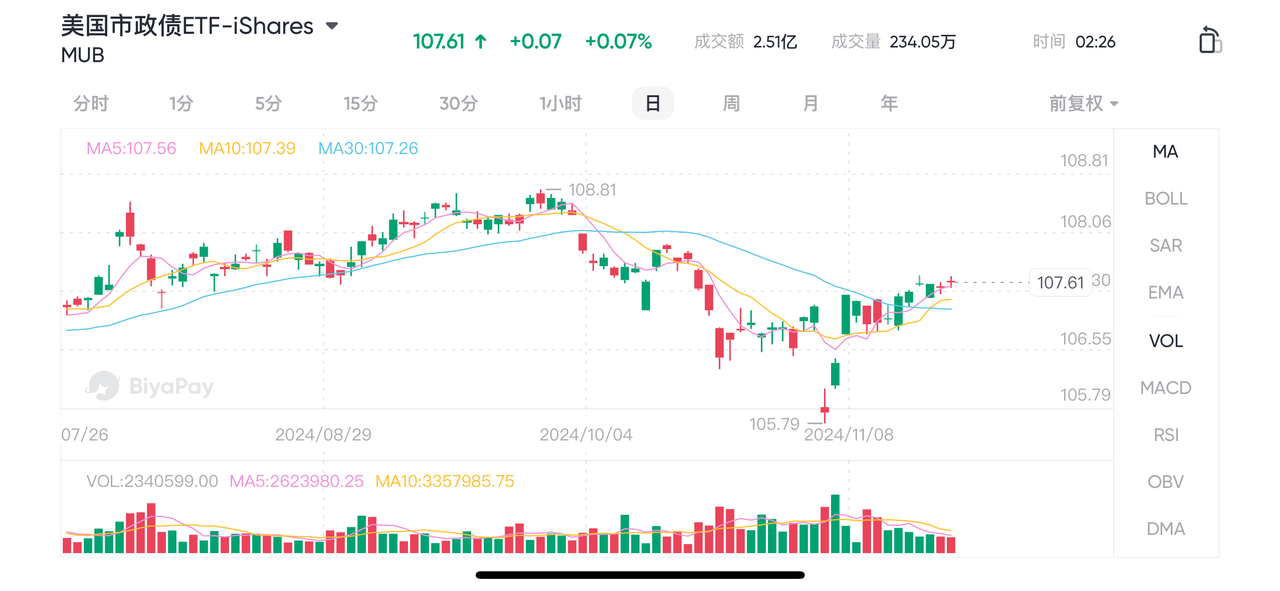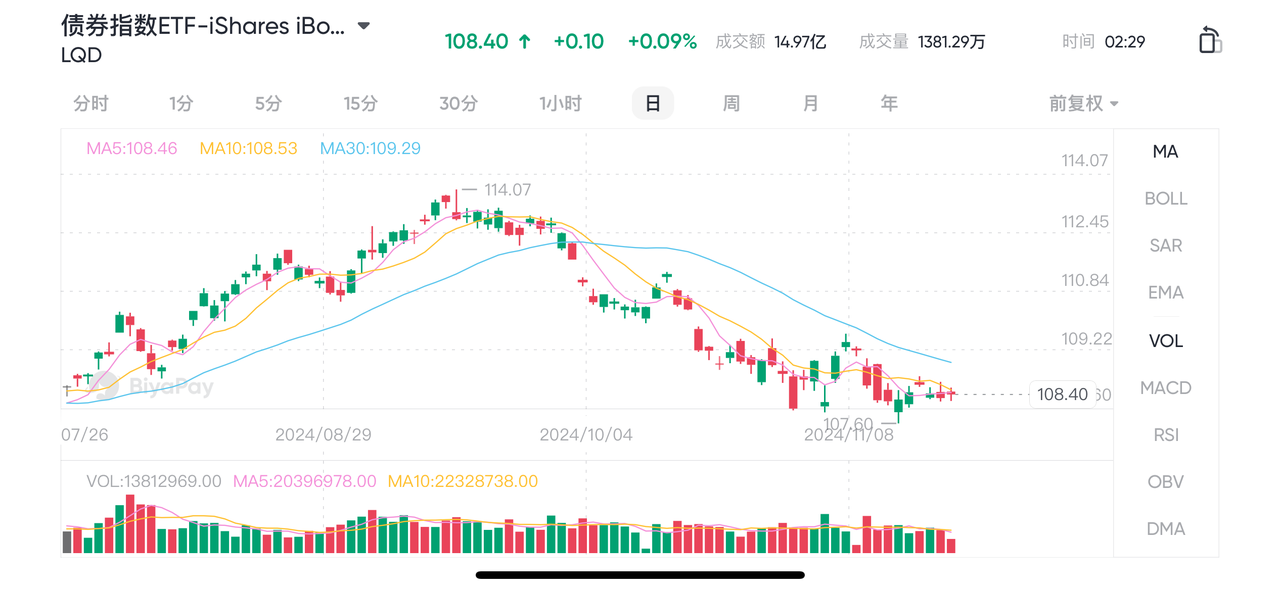- Remittance
- Exchange Rate
- Stock
- Events
- EasyCard
- More
- Download
US Treasuries Pull Back Again! Is It a Risk or an Opportunity? What Should We Do? What US Treasury E
As the US presidential election came to an end and the White House changed hands, the market once again entered a period full of uncertainties.
Under the intense “Trump Trade,” various assets have been significantly affected. Among them, one type of asset with relatively large fluctuations is - US Treasuries.
Before the interest rate cut in late September, the market had extremely high expectations for the performance of US Treasuries after the start of the interest rate cut, and the 10 - year US Treasury yield dropped to a low of 3.6%. However, in the nearly two months, it soared to around 4.4%, rising nearly 80 basis points from the previous low.
This also means that the interest - rate - cutting effect caused by the previous “front - running” of US Treasuries has almost been completely wiped out, and various overseas bonds have generally pulled back.
Who is behind the soaring US Treasury yields? Is the current bond market pull - back an opportunity or a risk? What should investors who currently hold US Treasury ETFs do?
Next, the author will discuss the above three questions with you.
Why Have US Treasury Yields Soared?
The start of the interest - rate - cutting cycle has led to a rise in US Treasury yields instead of a fall, which seems to be a somewhat counter - intuitive phenomenon.
Let’s first review the trend of the 10 - year US Treasury yield since the beginning of the year.
Since April, the 10 - year US Treasury yield has been declining from a high of 4.7%. As the Fed’s interest - rate - cutting expectations approached, the 10 - year US Treasury yield significantly pulled back to around 3.6% since July, and the overseas bond market also experienced a rally.
In the following two months, the factors that had previously pushed down the US Treasury yield all showed a certain degree of reversal:
1.Cooling of interest - rate - cutting expectations: US economic data in September was relatively strong, and employment data was better than expected, showing that the US economy was still robust. At the same time, the decline in inflation data was slightly less than expected, and subsequent interest - rate - cutting expectations also weakened.
2.The “Trump Trade” heated up: Trump won the election in early November, and the market then worried that Trump’s policies still had the risk of causing repeated inflation, which would affect the subsequent interest - rate - cutting path. The policy combination of “loose fiscal + tight monetary” might lead to a rise in the fiscal deficit rate, further pushing up long - term interest rates.
The combination of the above factors has caused US Treasury yields to climb all the way, and various overseas bonds have pulled back. Since the end of September, US Treasuries have fallen by 3.3%, the US Aggregate Bond Index has fallen by 3.24%, and US investment - grade bonds have fallen by about 2.9%. But overall, most overseas bond indices still achieved positive returns during the year.
Will US Treasuries Continue to Fall?
Will US Treasuries continue to fall? How long will they fall? These questions are difficult to answer.
However, since the reason for this round of US Treasury pull - back is the combined influence of the interest - rate - cutting path and Trump’s taking office, we might as well start from these two factors to analyze how US Treasuries might move in the future.
I. US Treasury Investments Have a High Winning Rate in Historical Interest - Rate - Cutting Cycles To understand a phenomenon, we should first look at its essence. The pricing logic of overseas bonds ultimately still depends on changes in the interest - rate environment. This is also the reason why the interest - rate - cutting cycle directly benefits US Treasuries.
In the six interest - rate - cutting cycles since 1980, although the 10 - year US Treasury yield fluctuated in different directions 1 - 3 months after the first interest - rate cut, it invariably declined throughout the interest - rate - cutting cycle, only with different magnitudes of decline. In the 1995 interest - rate - cutting cycle, the US Treasury yield also rebounded in the short term, but still declined overall.
Looking specifically at the performance of various bonds within 24 months after the interest - rate cut, whether it was a preemptive interest - rate cut or a recession - driven interest - rate cut, various US - dollar - denominated bonds reaped relatively handsome returns.
Although the Fed’s subsequent interest - rate - cutting pace may slow down and it is unlikely to be as aggressive as the first 50 - basis - point interest - rate cut, as long as the general direction of subsequent interest - rate cuts remains unchanged, US Treasuries are still an asset with a relatively high winning rate at present.
II. During Trump’s Last Term (Coupled with the Interest - Rate - Cutting Effect), the US Treasury Market Rose Overall
The second factor that led to the fall of US Treasuries is the “Trump Trade.” Policies such as domestic tax cuts, external tariff increases, and loose fiscal and tight monetary policies are all regarded as boosters of long - term interest rates, thus leading to the fall of US Treasuries.
But during Trump’s last term, did the “weak US Treasury” logic continue? The answer is no.
Looking back at Trump’s first term, at the beginning of Trump’s election in 2016, the long - term interest rate did rise significantly in a short period of time, and the US Aggregate Bond Index also pulled back. But a few months later, it returned to a reasonable fluctuation range. Then, after the interest - rate cut began in 2019, the US Treasury interest rate dropped significantly. During Trump’s entire term, the US Aggregate Bond Index rose nearly 20%.
In the current interest - rate - rise caused by the “Trump Trade,” there was a certain over - reaction in the market, but it was only a temporary disturbance and not the dominant factor affecting the US Treasury market. The current 10 - year US Treasury yield has returned to a relatively high historical level and still has some room for decline in the future.
What Should We Do Now? What US Treasury ETFs Are Worth Paying Attention To?
Next, let’s discuss how investors should respond to this round of US Treasury pull - back.
When the market is engaged in interest - rate - cutting transactions, the bond market usually performs well because bond prices usually rise as market interest rates fall. In addition, when the stock market is in panic, bonds, as a safe - haven asset, often benefit.
Bonds are very different from stocks. Many investors may have no experience in trading bonds and do not know the investment logic and methods. In fact, there is not only one way to invest in US Treasuries by direct purchase. Many investors can also indirectly allocate the bond market through US Treasury ETFs.
How to Select US Treasury ETFs?
As of 2024, there are more than 600 US Treasury ETFs, a dazzling array that makes investors feel confused. Among them, Treasury ETFs, Total Bond Market ETFs, and Corporate Bond ETFs are the three largest types, and the combined scale of the three accounts for about 80%.
US Treasury ETFs
1.20 - Year + Treasury ETF - iShares (TLT): TLT is an ETF that tracks the performance of long - term US Treasuries and mainly invests in US government bonds with a remaining maturity of more than 20 years. As a long-term Treasury ETF, TLT’s yield is closely related to the trend of long - term interest rates and usually performs better when market risk - averse sentiment rises or when a future interest - rate decline is expected. It provides an effective tool for exposure to long - term interest - rate risks and is suitable for investors seeking stable cash flow and safe - haven asset allocation.
Advantages: It has high liquidity, provides investors with a simple and effective way to obtain returns from the long - term US Treasury market, and the correlation between various bonds is low, making the investment portfolio more diversified.

2.US 1 - 3 - Month Treasury ETF - SPDR (BIL): BIL is an ETF that tracks the performance of the short - term US Treasury index and mainly invests in bonds issued by the US government with a remaining maturity of no more than 1 year. Since it invests in short - term Treasuries, BIL’s fluctuations are relatively small and can be used as a cash - management tool or a configuration choice for the lower - risk part of an investment portfolio.
Advantages: Low - risk, low - volatility, can provide investors with stable returns, and has high liquidity.
Disadvantages: Compared with long - term Treasuries, when interest rates fall, the capital appreciation of short - term Treasuries is limited, so it may not be able to obtain a high total return.

US Municipal Bond ETFs
1.US Municipal Bond ETF - iShares (MUB): MUB is an ETF that focuses on the US municipal bond market and invests in tax - exempt state and local municipal bonds. These bonds are usually used to finance public works and infrastructure construction, and the interest income can be exempt from federal income tax for eligible investors.
Advantages: For investors seeking stable income and hoping to reduce the tax burden on income, MUB is an ideal choice, especially under a higher marginal tax rate.
Disadvantages: Although the credit risk of municipal bonds is relatively low, it is not absolutely zero - risk, and individual municipal projects may still default. In addition, if investors do not need to pay federal income tax or the tax rate is low, the tax advantage may be weakened.

US Corporate Bond ETFs
1.Bond Index ETF - iShares iBoxx Investment - Grade Corporate Bonds (LQD): LQD is an investment - grade corporate bond ETF that tracks the performance of the iBoxx US - dollar - denominated investment - grade corporate bond index. This ETF holds bonds of many large and well - reputed companies. These companies usually have a sound financial condition and a high credit rating, providing investors with a relatively stable investment channel with a return higher than that of government bonds.
Advantages: Since it invests in investment - grade corporate bonds, LQD has a lower risk compared with high - yield bonds but can still provide a certain level of return. For investors seeking to increase fixed income and have a moderate exposure to risk, this is a suitable tool.
Disadvantages: Although the credit risk is relatively low, an economic recession or the deterioration of the financial condition of individual companies may lead to a downgrade of the credit rating, thus affecting LQD’s performance. In addition, compared with government bonds, the credit risk of corporate bonds always exists.

How to Conduct Investment and Trading of US Treasury ETFs?
Before investing (buying and selling) stocks, you first need to open a brokerage (stock) account. Just like you need to open a bank account before depositing money in a bank.
Investors can conveniently enter the US stock market through the multi - asset trading wallet BiyaPay App, conduct online real - time trading, and easily enjoy the returns brought by the market. At the same time, they can also recharge digital currencies (such as U) and withdraw US dollars/Hong Kong dollars to a bank account, and then deposit and withdraw funds to other brokerage platforms, easily solving the pain point of difficulty in funding US stocks.
BiyaPay Account Opening Process: Step 1: Download the BiyaPay App and register a new account with zero threshold. Step 2: Complete identity verification, upload your ID card or passport as required, and conduct face recognition. Step 3: Recharge legal tender to BiyaPay, click [Transfer], and you can directly transfer the legal tender from the capital account to the stock account. Or recharge digital currency to BiyaPay, quickly exchange the digital currency into US dollars, and then transfer the legal tender funds from the capital account to the stock account. Step 4: Find the US Treasury ETF in the BiyaPay App and trade it.
What Factors Affect the Price of US Treasury ETFs?
The price of US Treasury ETFs is mainly affected by the trend of the US Treasury market and, to a lesser extent, by US stocks.
1.Interest Rates Have the Greatest Impact on Bond Prices
The Fed’s actions and the market’s expectations of interest rates are the focus of attention. When the Fed raises/lowers the benchmark interest - rate level, US Treasury prices tend to fall/rise - Why is this?
Let’s take an example.
Imagine you have an IOU in your hand, which says that someone borrowed 1,000 yuan from you and promised to pay you 10 yuan in interest every month. After a while, the borrowing rate in the market generally decreased, and if someone wanted to borrow 1,000 yuan, they only needed to pay 5 yuan in interest per month.
As a result, the IOU with a higher interest rate in your hand becomes very popular. Because compared with a new IOU, the interest income of the one in your hand is more lucrative. If someone wants to buy your IOU, they are willing to pay a higher price than 1,000 yuan.
This IOU is like a bond. When the interest rate drops, market demand will drive the bond price up. Conversely, if the interest rate rises, the bond price will fall.
Another important rule is: the longer the bond’s maturity, the more sensitive its price is to interest rates. This means that bonds with a long maturity will rise more when interest rates are cut, but will also fall deeper when interest rates are raised.
2.Other Factors
1.US Fiscal Policy: Fiscal expansion policies will cause the government to increase the scale of bond issuance, thereby increasing bond supply and depressing market prices.
2.Inflation: The inflation rate directly affects the nominal interest rate and, in turn, the real interest rate.
3.International Relations: Foreign central banks are important buyers of US Treasuries, so international relations may affect the demand and price of US Treasuries and, thus, the entire US Treasury market.
4.The Impact of US Stocks: When US stocks fall, especially when the decline is large, funds with a need for safe - haven may turn to buy US Treasury ETFs.
Summary
Finally, let’s summarize.
Investors can choose long - term or short - term bond ETFs according to their own risk preferences. Generally, long - term bonds face higher interest - rate risks than short - term bonds.
Investors with a high risk - tolerance and who want to pursue higher returns may prefer high - yield corporate bond ETFs or emerging - market bond ETFs.
Investors who have no particular preference for bond types or do not want to spend too much time researching may consider investing in the entire bond market and choose a total - bond - market ETF.

























